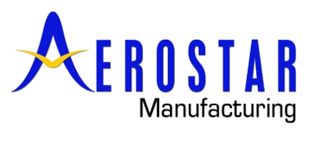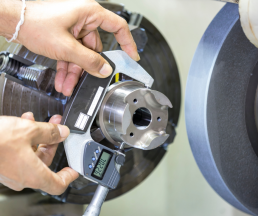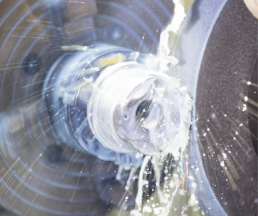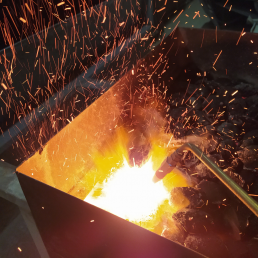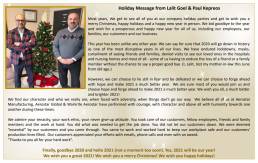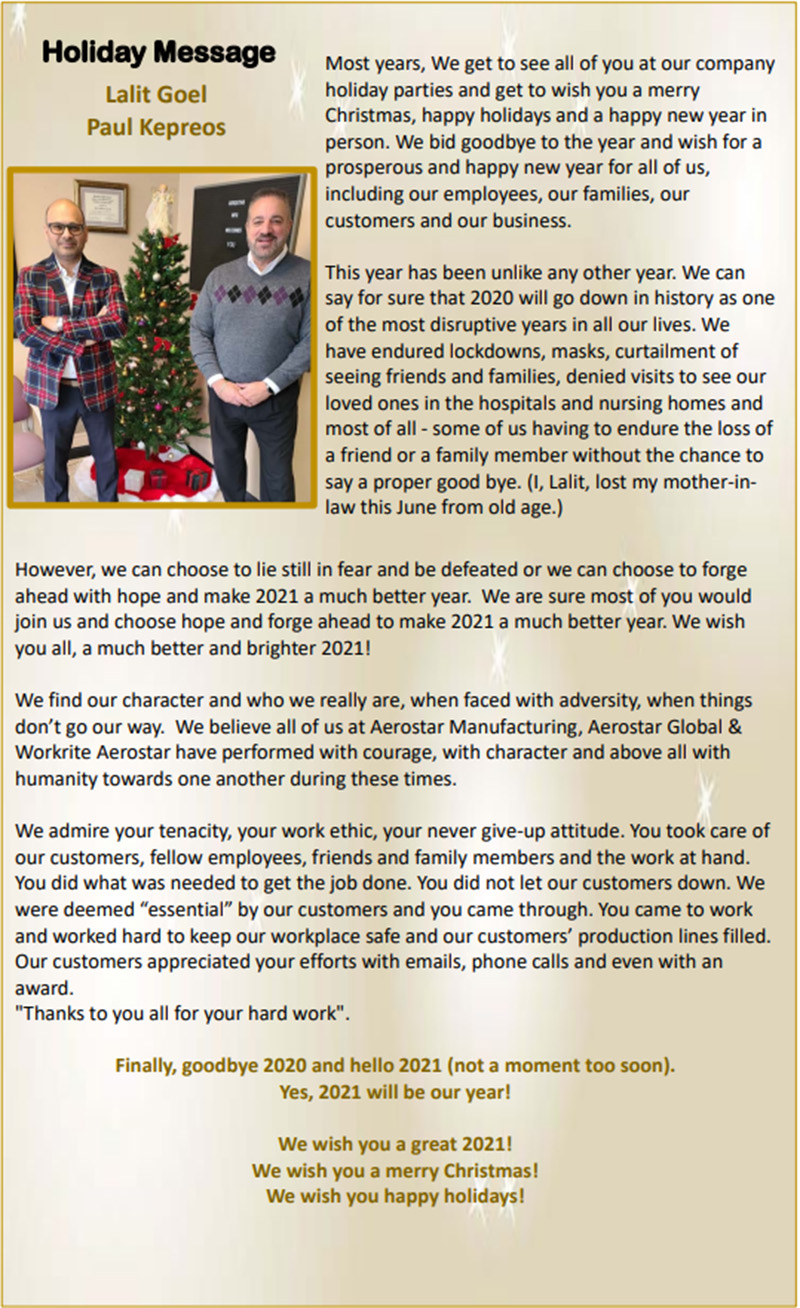Forgings where, why, how?
According to Forging:
"The North American forging industry continues to grow in technical prowess. OEMs are realizing that nothing beats forgings for strength and reliability. Advances in forging technology have expanded the range of shapes, sizes, and properties available in forged products to meet an increasing variety of design and performance requirements. Forgings are regularly specified where strength, reliability, economy, and resistance to shock and fatigue are vital considerations. Forged materials offer the desired degree of high or low temperature performance, ductility, hardness, and machinability.
Automotive and Truck
"In automotive and truck applications, forged components are commonly found at points of shock and stress. Cars and trucks may contain more than 250 forgings, most of which are produced from carbon or alloy steel. Forged engine and powertrain components include connecting rods, crankshafts, transmission shafts and gears, differential gears, drive shafts, clutch hubs, and universal joint yokes and crosses. Forged camshafts, pinions, gears, and rocker arms offer ease of selective hardening as well as strength. Wheel spindles, kingpins, axle beams and shafts, torsion bars, ball studs, idler arms, pitman arms, steering arms, and linkages for passenger cars, buses, and trucks typify applications requiring extra strength and toughness.
Aerospace
"High strength-to-weight ratio and structural reliability improve performance, range, and payload capabilities of aircraft. That's why ferrous and nonferrous forgings are used in helicopters, piston-engine planes, commercial jets, and supersonic military aircraft. Many aircraft are "designed around" forgings, and contain more than 450 structural forgings as well as hundreds of forged engine parts. Forged parts include bulkheads, wing roots and spars, hinges, engine mounts, brackets, beams, shafts, bellcranks, landing-gear cylinders and struts, wheels, brake carriers and discs, and arresting hooks. In jet turbine engines, iron-based, nickel-base, and cobalt-base superalloys are forged into buckets, blades, couplings, discs, manifolds, rings, chambers, wheels, and shafts--all requiring uniformly high-yield tensile and creep rupture strengths, plus good ductility at temperatures ranging between 1,000 and 2,000°F. Forgings of stainless steels, maraging steels, titanium, and aluminum find similar applications at lower temperatures. Forged missile components of titanium, columbium, super alloys, and refractory materials provide unduplicated mechanical and physical properties under severe service conditions. Aluminum structural beams for boosters, titanium motor cases, and nuclear-engine reactor shields and inflatable satellite launch canisters of magnesium are used in the space shuttle program.
Off-Highway and Agricultural
"Strength, toughness, machinability, and economy account for the use of ferrous forgings in off-highway and heavy construction equipment, and in mining machinery. In addition to engine and transmission parts, forgings are used for gears, sprockets, levers, shafts, spindles, ball joints, wheel hubs, rollers, yokes, axle beams, bearing holders, and links. Farm implements, in addition to engine and transmission components, utilize key forgings ranging from gears, shafts, levers, and spindles to tie-rod ends, spike harrow teeth, and cultivator shanks.
Ordnance
"Forged components are found in virtually every implement of defense, from rifle triggers to nuclear submarine drive shafts. Heavy tanks contain more than 550 separate forgings; armored personnel carriers employ more than 250. The majority of 155-mm, 75-mm, and 3-in. shells as well as mortar projectiles contain at least two forged components.
Valves and Fittings
"For valves and fittings, the mechanical properties of forgings and their freedom from porosity are especially suited to high-pressure applications. Corrosion and heat-resistant materials are used for flanges, valve bodies and stems, tees, elbows, reducers, saddles, and other fittings. Oilfield applications include rock cutter bits, drilling hardware, and high-pressure valves and fittings.
Industrial Hardware and Tools
"Stationary and shipboard internal combustion engines include forged crankshafts, connecting rods, rod caps, camshafts, rocker arms, valves, gears, shafts, levers, and linkages. Outboard motors, motorcycles, and power saws offer examples of the intensive use of forgings in smaller engines. Industrial equipment industries use forgings in materials handling systems, conveyors, chain-hoist assemblies, and lift trucks.
"'Forged' is the mark of quality in hand tools and hardware. Pliers, hammers, sledges, wrenches, and garden implements, as well as wire-rope clips and sockets, hooks, turnbuckles, and eye bolts are common examples. Strength, resistance to impact and fatigue, and excellent appearance are reasons why forgings have been the standard of quality since the earliest of times. The same is true of surgical instruments. Special hardware for electrical transmission and distribution lines is subject to high stresses and corrosion. For strength and dependability, forgings are used for parts such as pedestal caps, suspension clamps, sockets, and brackets.
Why are forgings prevalent?
"Since the dawn of mankind, metalworking has assured strength, toughness, reliability, and the highest quality in a variety of products. Today, these advantages of forged components assume greater importance as operating temperatures, loads, and stresses increase.
"Forged components make possible designs that accommodate the highest loads and stresses. Recent advances in forging technology have greatly increased the range of properties available in forgings.
"Economically, forged products are attractive because of their inherent superior reliability, improved tolerance capabilities, and the higher efficiency with which forgings can be machined and further processed by automated methods.
"The degree of structural reliability achieved in a forging is unexcelled by any other metalworking process. There are no internal gas pockets or voids that could cause unexpected failure under stress or impact. Often, the forging process assists in improving chemical segregation of the forging stock by moving centerline material to various locations throughout the forging.
"To the designer, the structural integrity of forgings means safety factors based on material that will respond predictably to its environment without costly special processing to correct for internal defects.
"To the production employee, the structural reliability of forgings means reduced inspection requirements, uniform response to heat treatment, and consistent machinability, all contributing to faster production rates and lower costs.
"Forgings are superior to metal parts produced by other methods in their compatibility with other manufacturing processes.
"The characteristically uniform refinement of crystalline structure in forged components assures superior response to all forms of heat treatment, maximum possible development of desired properties, and unequaled uniformity.
Because forged components of weldable materials have a near absence of structural defects, material at welding surfaces offers the best possible opportunity for strong, efficient welds by any welding technique.
"Again, the near absence of internal discontinuities or surface inclusions in forgings provides a dependable machining base for metal-cutting processes such as turning, milling, drilling, boring, broaching, and shear spinning; and shaping processes such as electrochemical machining, chemical milling, electrical-discharge machining, and plasma jet techniques.
"Forged parts are readily fabricated by assembling processes such as welding, bolting, or riveting. More importantly, single-piece forgings can often be designed to eliminate the need for assemblies.
"In many applications, forgings are ready for use without surface conditioning or machining. Forged surfaces are suited to plating, polishing, painting, or treatment with decorative or protective coatings
How Forgings are Produced
"Forging--metal shaping by plastic deformation--spans a myriad of equipment and techniques. Knowing the various forging operations and the characteristic metal flow each produces is key to understanding forging design.
Hammer and Press Forging
"Generally, forged components are shaped either by a hammer or press. Forging on the hammer is carried out in a succession of die impressions using repeated blows. The quality of the forging, and the economy and productivity of the hammer process depend upon the tooling and the skill of the operator. The advent of programmable hammers has resulted on less operator dependency and improved process consistency. In a press, the stock is usually hit only once in each die impression, and the design of each impression becomes more important while operator skill is less critical.
The Process
"Open Die Forging Open die forging with hammers and presses is a modern-day extension of the pre-industrial metalsmith working with a hammer at his anvil.
"In open die forging, the workpiece is not completely confined as it is being shaped by the dies. The open die process is commonly associated with large parts such as shafts, sleeves and disks, but part weights can range from 5 to 500,000 lb.
"Most open die forgings are produced on flat dies. Round swaging dies and V dies also are used in pairs or with a flat die. Operations performed on open die presses include:
"Drawing out or reducing the cross-section of an ingot or billet to lengthen it.
"Upsetting or reducing the length of an ingot or billet to a larger diameter.
"Upsetting, drawing out, and piercing--processes sometimes combined with forging over a mandrel for forging rough-contoured rings.
"As the forging workpiece is hammered or pressed, it is repeatedly manipulated between the dies until it reaches final forged dimensions. Because the process is inexact and requires considerable skill of the forging master, substantial workpiece stock allowances are retained to accommodate forging irregularities. The forged part is rough machined and then finish machined to final dimensions. The increasing use of press and hammer controls is making open die forging, and all forging processes for that matter, more automated.
"In open die forging, metals are worked above their recrystallization temperatures. Because the process requires repeated changes in workpiece positioning, the workpiece cools during open die forging below its hot-working or recrystallization temperature. It then must be reheated before forging can continue. For example, a steel shaft 2 ft in diameter and 24 ft long may require four to six heats before final forged dimensions are reached.
"In open die forging of steel, a rule of thumb says that 50 lb of falling weight is required for each square inch of stock cross-section.
"Compression between flat dies, or upsetting, is an open die forging process whereby an oblong workpiece is placed on end on a lower die and its height reduced by the downward movement of the top die. Friction between end faces of the workpiece and dies prevents the free lateral spread of the metal, resulting in a typical barrel shape. Contact with the cool die surface chills the end faces of the metal, increasing its resistance to deformation and enhancing barreling.
"Upsetting between parallel flat dies is limited to deformation symmetrical around a vertical axis. If preferential elongation is desired, compression between narrow dies (Fig. 1) is ideal. Frictional forces in the ax ial direction of the bar are smaller than in the perpendicular direction, and material flow is mostly axial.
"A narrower die elongates better, but a too-narrow die will cut metal instead of elongate. The direction of material flow can also be influenced by using dies with specially shaped surfaces.
"Compression between narrow dies is discontinuous since many strokes must be executed while the workpiece is moved in an axial direction. This task can be made continuous by roll forging (Fig. 2). Note the resemblance between Fig. 1 and Fig. 2. The width of the die is now represented by the length of the arc of contact. The elongation achieved depends on the length of this contact arc.
"Larger rolls cause greater lateral spread and less elongation because of the greater frictional difference in the arc of contact, whereas smaller rolls elongate more. Lateral spread can be reduced and elongation promoted by using specially shaped rolls (Fig. 3).
"The properties of roll-forged components are very satisfactory. In most cases, there is no flash and the fiber structure is very favorable and continuous in all sections. The rolls perform a certain amount of descaling, making the surface of the product smooth and free of scale pockets.
Impression Die Forging
"In the most basic example of impression die forging, which accounts for the majority of forging production, two dies are brought together and the workpiece undergoes plastic deformation until its enlarged sides touch the die side walls. Then, some material begins to flow outside the die impression, forming flash. The flash cools rapidly and presents increased resistance to deformation, effectively becoming a part of the tool. This builds pressure inside the bulk of the workpiece, aiding material flow into unfilled impressions.
"Impression die forgings may be produced on a horizontal forging machine (upsetter) in a process referred to as upsetting. In upsetting, stock is held between a fixed and moving die while a horizontal ram provides the pressure to forge the stock (Fig. 5). After each ramstroke, the multiple-impression dies can open to permit transfer of stock from one cavity to another.
"A form of impression die forging, closed die forging does not depend on flash formation to achieve complete filling of the die. Material is deformed in a cavity that allows little or no escape of excess material, thus placing greater demands on die design.
"For impression die forging, forging dies become more important, and operator skill level is less critical in press forging operations. The press forging sequence is usually block and finish, sometimes with a preform, pierce, or trim operation. The piece is usually hit only once in each die cavity.
Ring Rolling
"Ring rolling has evolved from an art into a strictly controlled engineering process. Seamless rolled rings are produced on a variety of equipment. All give the same product--a seamless section with circumferential grain orientation. These rings generally have tangential strength and ductility, and often are less expensive to manufacture than similar closed die forgings. In sum, the ring rolling process offers homogeneous circumferential grain flow, ease of manufacture, and versatility in material, size, mass, and geometry.
"In the ring rolling process, a preform is heated to forging temperature and placed over the idler (internal) roll of the rolling machine. Pressure is applied to the wall by the main (external) roll as the ring rotates. The cross-sectional area is reduced as the inner and outer diameters are expanded. Equipment can be fully automated from billet heating through post-forge handling. Advanced ring rolling equipment can roll contours in both the inner and outer diameter of the ring, allowing for excellent weight reductions, material savings, and reduced machining cost.
"There is an infinite variety of sizes into which rings can be rolled, ranging from rollerbearing sleeves to rings of 25 ft in diameter with face heights of more than 80 in. Various profiles may be rolled by suitably shaping the drive and idling rolls.
"Extrusion In extrusion (Fig. 6), the workpiece is placed in a container and compressed until pressure inside the metal reaches flowstress levels. The workpiece completely fills the container and additional pressure causes it to travel through an orifice and form the extruded product.
"Extrusion can be forward (direct) or backward (reverse), depending on the direction of motion between ram and extruded product. Extruded product can be solid or hollow. Tube extrusion is typical of forward extrusion of hollow shapes, and backward extrusion is used for mass production of containers.
"Piercing is closely related to reverse extrusion but distinguished by greater movement of the punch relative to movement of the workpiece material.
"Secondary Processes Besides the primary forging processes, secondary operations often are employed. Drawing through a die is a convenient way to eliminate forged draft (Fig. 7a). The mode of deformation is tangential compression. The diameter of the drawing ring can be slightly smaller than the outer diameter of the preforged shell to control or reduce wall thickness and increase the height of the shell in a drawing or ironing operation (Fig. 7b).
"Bending can be performed on the finished forging or at any stage during its production.
"Because forging stock may assume complex shapes, it is rare that only a single die impression is needed. Preforming the forging stock--by bending or rolling it, or by working it in a preliminary die--may be more desirable. Gains in productivity, die life, and forging quality often outweigh the fact that preforming adds an operation and attendant costs. Forging in one final die impression may be practical for extremely small part runs.
"Since bending of larger parts requires a machine of long stroke, special mechanical or hydraulic presses are often necessary. Simple shapes can be bent in one operation, but more complex contours take successive steps. If complex shapes are to be formed in a single operation, the tool must contain moving elements.
"Special Techniques After deformation, forged parts may undergo further metalworking. Flash is removed, punched holes may be needed, and improved surface finish or closer dimensional accuracy may be desired.
"Trimming-- Flash is trimmed before the forging is ready for shipping. Occasionally, especially with crack-sensitive alloys, this may be done by grinding, milling, sawing, or flame cutting.
"Coining--Coining and ironing are essentially sizing operations with pressure applied to critical surfaces to improve tolerances, smoothen surfaces, or eliminate draft.
"Coining is usually done on surfaces parallel to the parting line, while ironing is typified by the forcing of a cup-shaped component through a ring to size on outer diameter. Little metal flow is involved in either operation and flash is not formed.
"Swaging--This operation is related to the open die forging process whereby the stock is drawn out between flat, narrow dies. But instead of the stock, the hammer is rotated to produce multiple blows, sometimes as high as 2,000 per minute. It is a useful method of primary working, although in industrial production its role is normally that of finishing. Swaging can be stopped at any point in the length of stock and is often used for pointing tube and bar ends and for producing stepped columns and shafts of declining diameter.
"Hot Extrusion-- Extrusion is most suitable for forming parts of drastically changing cross section and is, therefore, a direct competitor to continuous upsetting and the horizontal forging machine. In Fig. 8, a bar section of car efully controlled volume is heated, descaled, and placed into the die. Under pressure of the closely fitting punch (Fig. 8a), the material first fills the cavity, then part of it is extruded into a long stem. At the end of the stroke (Fig. 8b), a valve body is obtained that needs only grinding of the seating surfaces.
"There are a number of variants of the extrusion process, many of them patented. The slug may be hollow (machined), pierced in a separate operation or in the extrusion process itself. In all instances, the quality of heating, the efficiency of scale removal or prevention, and the effectiveness of lubrications are matters of greatest importance. The variety of shapes produced are numerous. Dimensional accuracy, surface quality, and productivity are high, and a greater degree of deformation can be achieved in a single operation than in any other forging method."
Hybrid Forging: Advances in Open Die and Closed Die Forging
According to Thermal Processing:
"Using the advantages of open die forging combined with the near-net shape capability of closed die forging, the forging process can be tailored to optimize time and cost savings.
"Today’s high-strength material users are increasingly obliged by everyday economic and competitive realities to seek alternatives to their current manufacturing processes. The reality that forgings can be used for more than simple parts — and forged at very large sizes and unique geometries — is slowly being realized. Companies who are looking for a better competitive advantage have started seeking the help of forging facilities with the metallurgical know-how to deliver improved products, processes, and especially costs.
"Forgings target a lower total cost when compared to a casting or fabrication. When considering all the costs that are involved in a product’s life cycle from procurement to lead time to rework and then factoring in the costs of scrap, downtime, and further quality issues, the long-term benefits of forgings far outweigh the short-term cost savings that castings or fabrications might offer.
"Due to computer-aided design, close customer collaboration, and creative forging techniques, advanced forging companies have been able to combine the advantages of open die forging with the near-net shape capability of closed die forging to tailor a forging process that optimizes time and cost savings. These hybrid open die, closed die designs allow for part flexibility and economic advantages for gearing innovation and are ideal for prototypes or low-volume production where the die block cost for impression die does not provide economic justification. The immediate availability of this tooling can also allow for a shortened production lead time, offering flexible order quantities and reduced lead time in situations where needed.
How it works
"Instead of pushing 100 percent of the material’s surface area, hybrid forgers are able to use far less tonnage in a prescribed manner to move material more efficiently. This is due to the tooling and mechanics of the process. For impression die (or closed die), a forging company must manipulate 100 percent of the workpiece at the same time. So it comes down to pounds per square inch, which is why this hybrid process makes it possible to make larger, more complex parts on an open die press. It’s also a more efficient use of tooling and investment dollars; the tool design can be changed quicker and more effectively than closed die impression blocks or casting molds.
Hybrid gear case study
"For example, a typical bull gear is manufactured in three parts: a rim, a hub, and a plate welded together. Fabricating a gear from multiple parts increases the risk for error and requires continual sourcing management. Added processing for welding of the fabrication proves to be costly and time-consuming. Not only is coordinating the manufacturing and shipment of all three components tedious, but someone also has to manage the requirement flow-down and payment schedule from different vendors. From a product standpoint, cracking in the weld layer is common, causing failures in the field that require extensive weld repair and re-inspection.
"Fortunately, this product can be manufactured as a single-piece hybrid forging, improving properties and eliminating non-value-added steps. The strength and structural integrity of the forged material meets demanding application requirements, resulting in less rework, fewer rejections, and increased part life. The elimination of welding shortens part-production process time, and the component is better able to withstand the rigors of field use. The ultimate benefit, however, is that the component can be turned around faster and machine-finished for immediate production response. A single-piece forging is much less prone to error and setback due to the removal of steps, such as managing multiple suppliers and welding.
"Hybrid forging compared to castings and fabrications
When compared to alternative metalworking processes, forging delivers significant economic, manufacturing, and quality advantages such as directional strength, structural strength, and impact strength.
Directional Strength
"By mechanically deforming the heated metal under tightly controlled conditions, forging produces predictable and uniform grain size and flow characteristics. Forging stock is also typically pre-worked to refine the dendritic structure of the ingot and remove porosity. These qualities translate into superior metallurgical and mechanical qualities and deliver increased directional toughness in the final part.
Structural Strength
"Forging also provides a degree of structural integrity that is unmatched by other metalworking processes. Forging eliminates internal voids and gas pockets that can weaken metal parts. By dispersing segregation of alloys or non-metallics, forging provides superior chemical uniformity.
Impact Strength
"Parts can also be forged to meet virtually any stress, load, or impact requirement. Proper orientation of grain flow assures maximum impact strength and fatigue resistance. The high-strength properties of the forging process can be used to reduce sectional thickness and overall weight without compromising final part integrity.
Grain Flow
"Forging also provides means for aligning the grain flow to best obtain desired directional strengths. It is well-known that bridges are prone to cracking and fatigue problems. Therefore, it is helpful to understand how proper orientation of grain flow can ensure maximum fatigue resistance.
"In open die forging, the metal — once subjected to the compressive stress — will flow in any unconstrained direction. The expanding metal will stretch the existing grains and, if the temperature is within the forging temperature region, will recrystallize and form new strain-free grains. This results in even better resistance to fatigue and stress corrosion than a forging that does not contour the component.
"This predictable structural integrity inherent to the forging process reduces part inspection requirements, simplifies heat treating and machining, and ensures optimum part performance under field-load conditions. The high-strength properties of the forging process can be used to reduce sectional thickness and overall weight without compromising final part integrity.
Forged Grain Flow
"Forgings to near-net shape offer contoured grain flow, yielding greater impact and directional strength. Grain flow is oriented to improve ductility and toughness and increase fatigue resistance.
Cast Grain Flow
"Castings typically do not have a grain structure, which is not desirable for critical, load-bearing components.
Machined Grain Flow
"Machined parts have a unidirectional grain flow that has been cut when changing contour, exposing grain ends. This renders the material more liable to fatigue and more sensitive to stress corrosion cracking.
Additional benefits
"Forging can also measurably reduce material costs, as it requires less starting stock to produce many part shapes. Therefore, less machining is needed to finish the part with the added benefits of shorter lead time and reduced wear and tear on equipment. Virtually all open die forgings are custom-made one at a time, providing the option to purchase one, a dozen, or hundreds of parts as needed. In addition, the high costs and long lead times associated with casting molds or closed die tooling and setups are eliminated.
"Furthermore, by providing weld-free parts produced with cleaner, forging-quality material and yielding improved structural integrity, forging can virtually eliminate rejections (as opposed to fabrications). Using the forging process, the same part can be produced from many different sizes of starting ingots or billets, allowing for a wider variety of inventoried grades. This flexibility means that forged parts of virtually any material or geometry can be manufactured relatively quickly and economically."
What is the difference between forging and machining?
Have you considered the differences between forging and machining?
According to LinkedIn:
"Forging and machining is mainly metalworking processes, when to forge and when to machine? It is real question for HVAC service technician. Here’s you can review the guide below for a better idea of choosing right process for your cooling system like air conditioner and condenser coils unit.
What is forging?
"In simply terms, forging is the process of forming and shaping metals through the use of hammering, pressing or rolling including the open die and rolled ring forging process.
What is machining?
"As like wikipedia said a piece of raw material is cut into a desired final shape and size by a controlled material-removal process. collectively known as subtractive manufacturing,In processing it can’t change raw material properties itself except shape.
Forging’s benefit
"To keep grain flow intact.
"As we know during machining, grain ends are exposed and metal parts are more susceptible to weakening and cracking. Forging process provide refined grains replacement for previous metal grain structure which has been broken in process. And keep the grain flow intact.
To improve part integrity
"Forging is eliminating material structural voids which can weaken metal parts. It provide a level of uniformity to improve metal parts performance.
For material saving
"Take open-die forging for example, your metal parts is sharped by the dies, which can help you reduce waste and material cost, when you machining a product from bar, the Conor stock is lost, you are still required to pay for excess material.
When to forge, when to machine?
"When air conditioner service technician must select a process for production of a critical metal component like brass fittings (flaring nuts, union, Tee, etc), he will face an enormous possible alternatives including machining.
"In fact, forging is often the optimum process, in terms of both part quality and cost, especially in demanding industrial application like maximum strength, durability, custom sizes and critical performance, forging is likely better suited to your needs."
Aerostar Touts Success of Reusable Dunnage Program


Seeking new ways to save costs and streamline the shipping process, Aerostar Manufacturing’s Technical Sales Manager Ken Krasnodemski, had a brilliant idea. Looking over the books, Krasnodemski noticed the sizable cost of expendable packaging: tens of thousands of dollars spent annually on cardboard packaging from suppliers coming into the plant.
Always eager to find a better process, Krasnodemski found a viable alternative in reusable packaging. He proposed investing in their own collapsible reusable packages for shipping parts and castings to and from their supply base.
“Originally I was focused just on the cost savings aspect of this project,” said Krasnodemski, “but the positive impact it would make on the environment became quickly apparent and assisted in an expedited approval process on the investment.” Today, his reusable dunnage program has been successfully saving Aerostar money (and protecting the environment) for over 6 years.
Many parts shipped in by suppliers are transported in reusable packaging that’s long been paid for. By modest estimates, Aerostar saves more than $60,000 per year in packaging and labor costs combined. They’ve also prevented thousands of pounds of cardboard from being made and ultimately ending up in landfills.
Sometimes small ideas can have a huge overall impact on finances and the environment.

Aerostar Helps North American Manufacturers Diversify into India: Companies are moving manufacturing out of China




Recently Bloomberg/Businessweek weekly, mentioned that Young Liu, chairman of Hon Hai Precision Industry Co, declared that China’s days as the world’s manufacturing hub are over. The declaration comes with some heavy industry backing as Foxconn will be splitting its supply chain between the Chinese market and the US.
Enter Aerostar, a CNC precision manufacturing company based in Romulus, MI and Fort Wayne, Indiana is expanding its footprint in India. Its offices in Pune and Bengaluru, India are helping many American OEMs and Fortune 500 companies source manufactured components out of India, i.e.: machined castings, forgings, plastic injection molding parts, gears, assemblies, etc. It’s both: cost savings and risk mitigation for the customers. All the manufacturing facilities are IATF 16949 and or AS 9100.
Aerostar continues to help North American manufacturers save over 30% by sourcing engineering components in India through its partner supply base. Just in the past 3 months, Aerostar has received dozens of engineering component packages from new customers to be sourced in India and the US. The expanded activity in India doesn’t replace Aerostar’s US manufacturing however, but rather allows for dual sourcing options for its US customers.
The face of manufacturing is changing across the world, new supply chains are being created to mitigate risk and save costs. Companies like Aerostar offer excellent, competitive pricing, tight timelines and truly impressive quality.

Aerostar Presented “2020 Cummins COVID-19 Outstanding Supplier” Award for Excellent, Uninterrupted Service


Aerostar Presented “2020 Cummins COVID-19 Outstanding Supplier” Award for Excellent, Uninterrupted Service
With over 40 years in the manufacturing industry, Aerostar Mfg has faced many trials, but 2020’s pandemic outbreak has brought the most traumatic supply chain challenges faced in recent history. This year Aerostar stepped up to that challenge, protecting both employees and clients with outstanding, uninterrupted service throughout the Covid-19 pandemic.
That’s why Aerostar is being recognized with a 2020 Cummins COVID-19 Outstanding Supplier award. Established this year, Cummins was inspired to recognize companies that have taken on the heavy burden of continuing safe service throughout the crisis. The recognition is offered only to those suppliers who have gone above-and-beyond to support Cummins during COVID-19, like Aerostar Mfg.
Cummins recognized that dedication from Aerostar has allowed them to provide essential products and services to customers throughout the crisis. Aerostar’s support of Cummins, notably including their dedicated management team staying in close communications with Cummins and their commitment to employee safety have allowed production to continue uninterrupted throughout the outbreak.
Despite worldwide challenges, Aerostar is continuing to grow this year and focus on client satisfaction as well as continued, quality-focused and safe manufacturing practices.

Aerostar Welcomes new International Sourcing Leader


Intent on expanding global sourcing for its US customers, Aerostar Global has hired Sushrut Deshmukh to join its skilled team as International Sourcing Leader at India office in Pune. Sushrut likes traveling, experiencing different foods and cultures, and creating strong networks with people he meets along the way.
Equipped with 20 years industry experience Sushrut Deshmukh lends essential skills to the Aerostar global team. His most critical role is in development and implementation of effective sourcing strategies. These strategies are a combination of managing risk mitigation, capacity ramp up, process improvements, all while enhancing quality control.
Sushrut loves people and believes in creating strong personal bonds. “Work never seems like work,” said Sushrut, as he spearheads large sourcing projects in India for Aerostar’s US customers.
Aerostar Global is thrilled to welcome an International Sourcing Leader with strong skills and experience to its team. Sushrut will be working toward strategic growth plans for Aerostar Global Sourcing and to develop a world-class supply base for sourcing of castings, forgings, precision machining and complex assemblies for exports to its US customer base.
With an eye on expanding its sourcing and supply chain, Aerostar will continue to grow its Global team to help US customers outsource machined parts and assemblies.

Aerostar increases its Bench Strength to Help US companies Source from India


Aerostar increases its Bench Strength to Help US companies Source from India
Expanding their newest facility, Aerostar hires new processing engineer, Gopinath Chakkaravarthy, for CNC Manufacturing at its Bengaluru office in India. The position focuses on programming, an integral part of the manufacturing process that supports supply chain services for Aerostar’s US customers.
Gopinath Chakkaravarthy brings 16 years of CNC Programming experience including work for big name global industries along with strong team building skills to bring the best out of coworkers. Ready for a challenge, Chakkaravarthy is taking the lead as Aerostar’s Manufacturing Process Engineer through MasterCAM.
Aerostar is eager to welcome a programmer with such strong skills and experience to the team. Chakkaravarthy’s responsibilities include 3, 4, & 5 axis CNC mill programming for all machines located in the US and at suppliers worldwide, as well as specialty tool design, lathe programming for all machines. CNC cycle time estimation, fixture design and tool design. All programming will support Aerostar Manufacturing’s efforts in sourcing castings, forgings, precision machining and complex assemblies for exports to its US customer base.
With an eye on expanding its sourcing and supply chain, Aerostar will continue to grow its team in India to help US customers outsource machined parts and assemblies from India.

